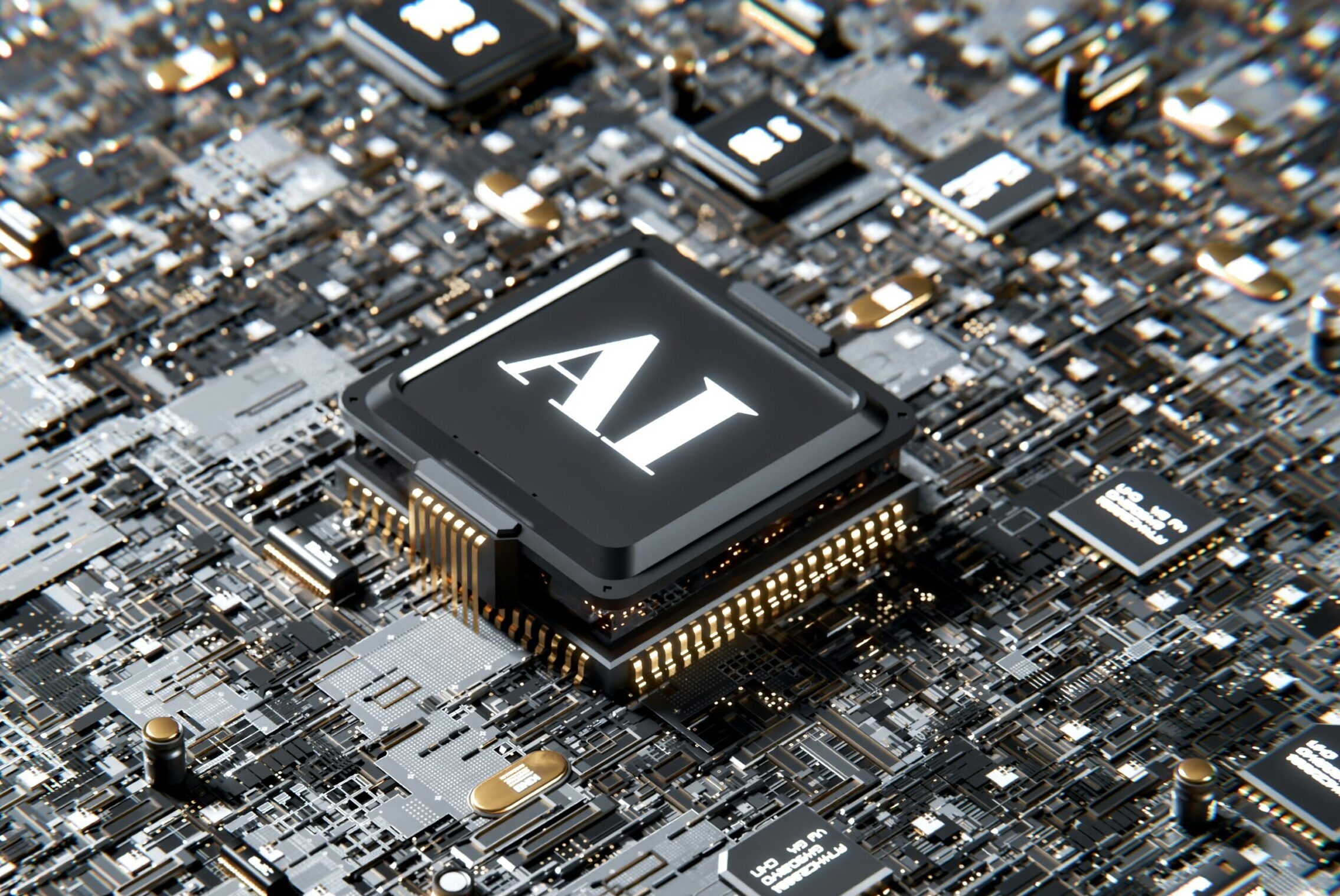Month: March 2019

The 2019 Game Developers Conference (GDC), held last week in San Francisco, welcomed an estimated 20,000-plus developers, gamers, publishers and tech vendors from across the globe. From the tech driving the future of gaming to the industry’s most prevalent conversations and trends, here are five takeaways and headlines from the 13th annual show.
No. 1: Cloud Gaming Has Arrived
Compared to consumer-oriented conferences like E3 and the Consumer Electronics Show (CES), GDC hasn’t traditionally been well-known for its headline-generating announcements. That wasn’t the case this year, as Google generated major buzz with the official introduction of its cloud gaming platform, Stadia.
According to Google, Stadia will be capable of streaming AAA titles from its cloud platform straight to any device through the Chrome browser—no console required. This service is slated to launch later this year into a market that’s already been heating up; Amazon and Microsoft are both expected to release their offerings later this year as well.
With established services like PlayStation Now and emerging cloud-based gaming solutions like the high-end gaming computer Shadow, an INAP customer that launched in the U.S. last year, the race for cloud gaming dominance seems like it will be one of the biggest stories to watch in 2019 and beyond.
No. 2: Developers Are Attacking Multiplayer Scale and Performance From Multiple Angles
Infrastructure and network performance for multiplayer games was a dominant theme throughout the full week of conference sessions. Designing, scaling and securing infrastructure, all while minimizing latency, remains an ever-evolving, persistent challenge for studios and developers.
All the major cloud players were on hand to pitch their gaming-specific infrastructure and network solutions, but hyperscale cloud was not the only infrastructure solution with a compelling online gaming use case.
Less than two months after the hugely successful launch of Apex Legends, Respawn Entertainment and its server hosting partner Multiplay provided a behind-the-scenes look at how a bare metal-first strategy helped the game scale from 5 million players in its first three days to 50 million players in its first full month.
“Multiplayer game launches should be boring, operationally at least,” said Larry Rye, lead solutions engineer at Multiplay. “The last thing you should worry about is game servers.”
Rye explained that Multiplay prioritized allocation of Apex Legends sessions to bare metal servers to optimize both performance and keep costs down, moving game instances to the public cloud only when all dedicated servers were at capacity.
Bare metal is well-suited to these kinds of demanding gaming applications, where speed and performance are paramount. For more information about the infrastructure behind some of your favorite games, take a look at our recent blog post covering what a high-performance, built-for-gaming bare metal deployment looks like (and why INAP’s bare metal and colocation can give you an edge because they’re plugged into our robust network and our proprietary, automated route optimization engine Performance IP).
No. 3: Esports Rising
The global esports market is set to reach $1 billion in 2019, and unsurprisingly, the still-young industry was a popular topic all week at GDC. Roughly a dozen conference sessions took aim from all angles: from improving the quality of online tournaments and governance of collegiate esports programs to career development tips and live audience engagement tactics.
Doug Higgins, co-founder of Sapphire Ventures, spoke about the ways esports are likely to be monetized in the years to come.
“You need to have a diversified revenue stream,” he said. “Comparing esports to traditional sports, three revenue streams are already pretty established—sponsorships, broadcasting rights and match day revenue.”
To increase investor confidence, however, Higgins expressed the need for esports to develop more solid constructs around how leagues will function at all levels.
“It’s to everyone’s benefit if esports is done the right way,” he concluded.
No. 4: Independent Developers Shine (Again)
GDC is a perennial draw for indie developers and studios, serving up a variety of hands-on showcases (including a Shark Tank-style game pitch competition). The popular alt.ctrl.GDC returned for its sixth year, featuring 20 creative, accessible and immersive uses of alternative controllers in original games.
👀 Some highlights from alt.ctrl.GDC, always one of our favorite parts of GDC #GDC19
— INAP (@PoweredbyINAP) March 22, 2019
The 21st Independent Games Festival Awards, held Wednesday, honored an impressive and diverse array of titles. Return of the Obra Dinn, a beautifully illustrated murder mystery adventure by Papers, Please developer Lucas Pope, won both the Seamus McNally Grand Prize and the award for Excellence in Narrative. All IFG titles were playable on the exhibition floor.
In other noteworthy news for aspiring developers, Epic Games, developer of Fortnite, announced a $100 million mega-grant for developers, artists and creators using Unreal Engine. Individual grants will range from $5,000 to $500,000 and recipients will retain rights to their work.
No. 5: Building Healthy Gaming Communities Takes Center Stage
Several highly attended sessions focused on the role of developers in building both games and gaming communities that are healthy, accessible and inclusive.
Psychologist Celia Hodent, author of The Gamer’s Brain: How Neuroscience and UX Can Impact Video Game Design, spoke about ethics in the gaming industry, particularly the need for developers to treat issues like addiction and manipulative monetization practices with care, using the latest scientific research as a guide.
Referencing the U.S. Federal Trade Commission’s plans to hold workshops on the use of loot boxes in games, Hodent encouraged attendees “to address it before we get regulations on it.” Specifically, she recommended studios and publishers avoid using the loot box mechanics in games rated “Teen” and “Everyone” and restrict third-party marketplaces where digital loot can be sold.
Challenges and opportunities for improvement aside, the gaming industry and its influence in society have arguably never been stronger.
Roger Altizer, associate director of the Entertainment Arts and Engineering program at University of Utah, showcased a litany of research detailing the many ways video games can improve one’s physical and psychological health, as well as contribute to culture in ways that transcend passive entertainment.
“Folks love talking about negative aspects of games,” he told attendees. “Instead, we need to start from the assumption that games are good for you.”
Explore HorizonIQ
Bare Metal
LEARN MORE
Stay Connected
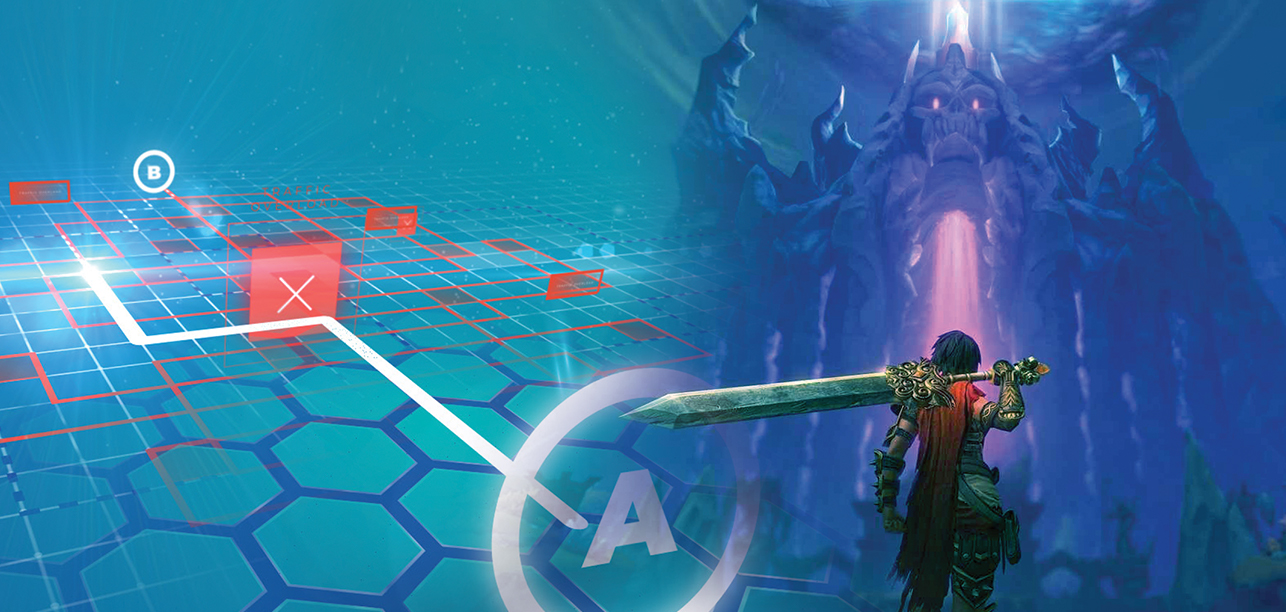
INAP Customer Story: See How Hi-Rez Studios Provides Seamless Online Gaming Experiences to Millions Worldwide
To the eSports and online gaming community, Hi-Rez Studios needs no introduction. The company’s massively popular titles—which include the multiplayer online battle arena (MOBA) game SMITE and objective-based team first-person shooter Paladins—have been played by more than 70 million people worldwide, putting the company at the forefront of the free-to-play, games-as-a-service industry.
Since 2008, Hi-Rez has powered its games via INAP Bare Metal, custom managed hosting and the patented, latency-busting network optimization technology: Performance IP®. Today, 100 percent of Hi-Rez’s ever-increasing gaming traffic is routed through INAP data centers.
“In online games, lag kills,” said Todd Harris, Chief Operating Officer at Hi-Rez. “To deliver the best experience, we have to make sure that gamers are able to play on the best network while using the most efficient route. INAP delivers all of that.”
Our latest customer story with Hi-Rez, debuting this week at Game Developers Conference 2019, frames the partnership through the lens of a multiplayer match interface—from the party select and weapon loadout menus through the stage results and achievements.
Read “Titans of Performance” below and download or share the eBook via Slideshare.
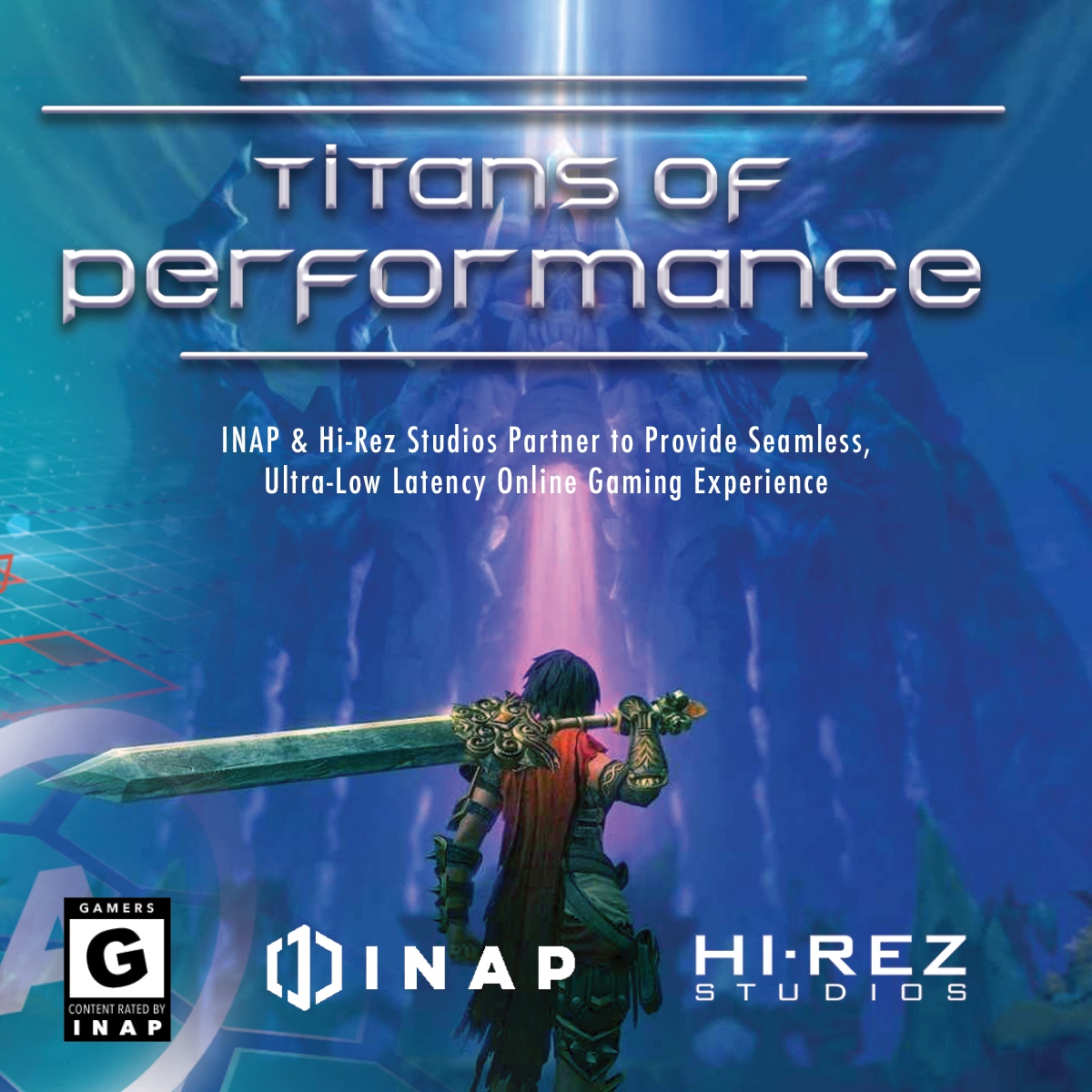
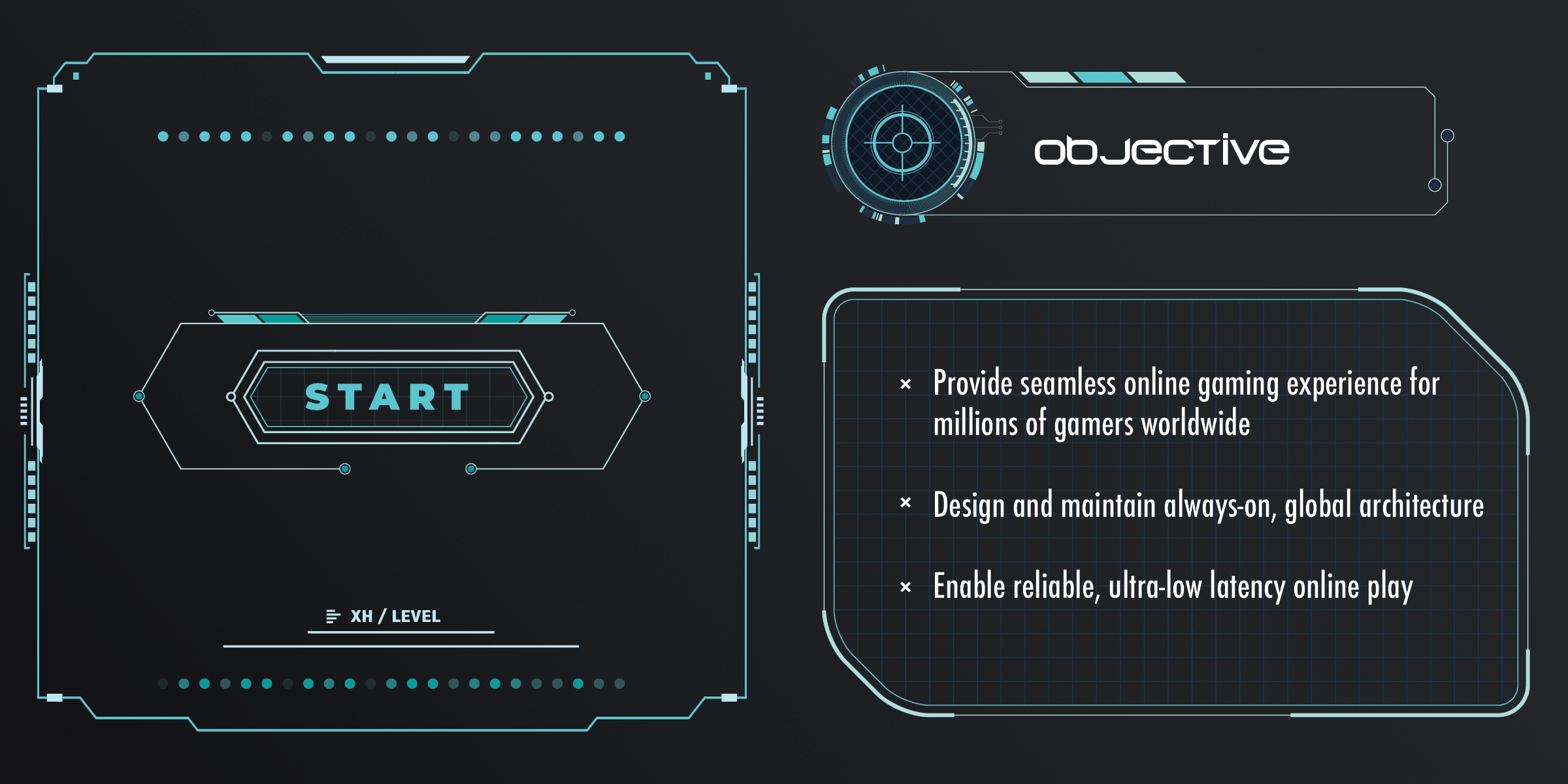
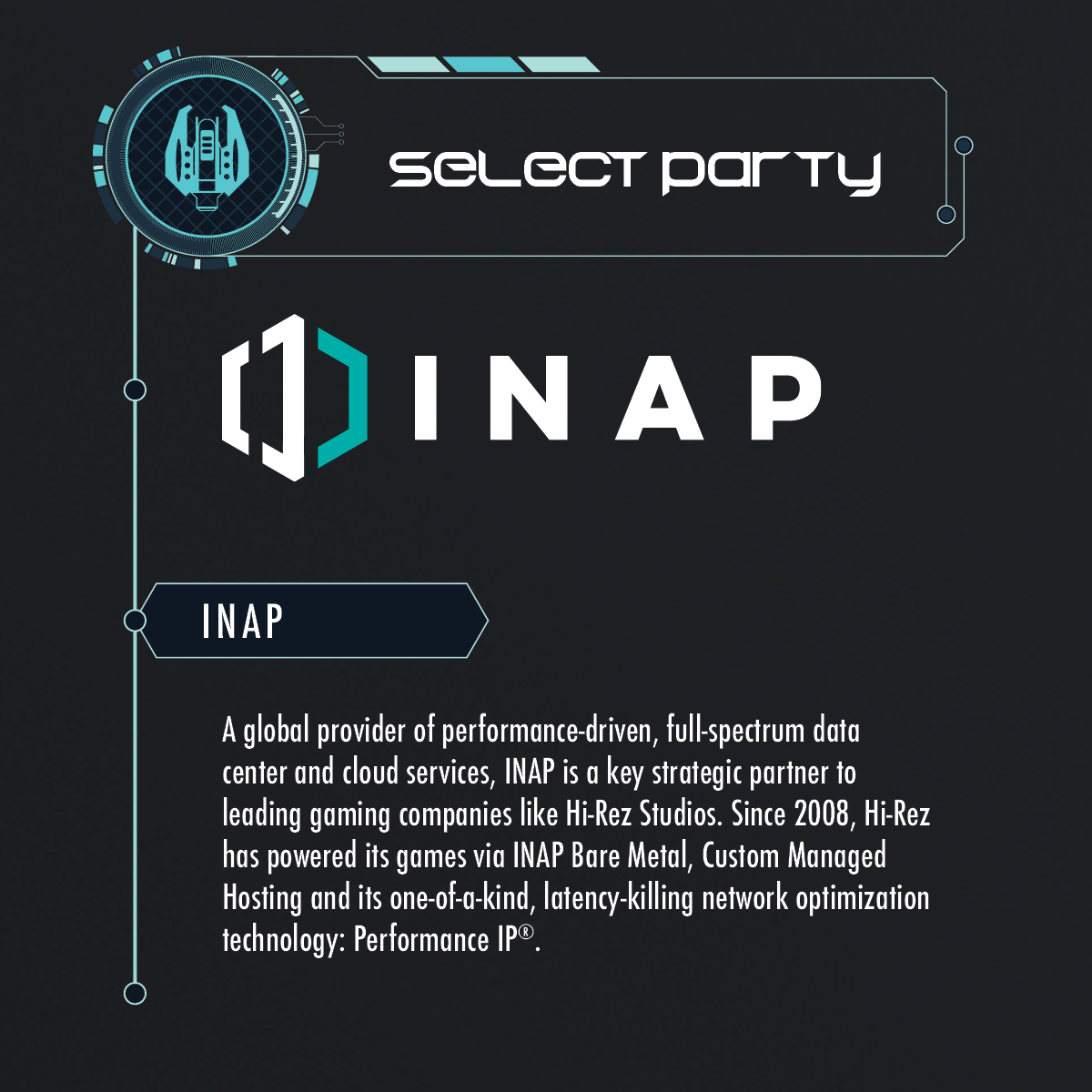
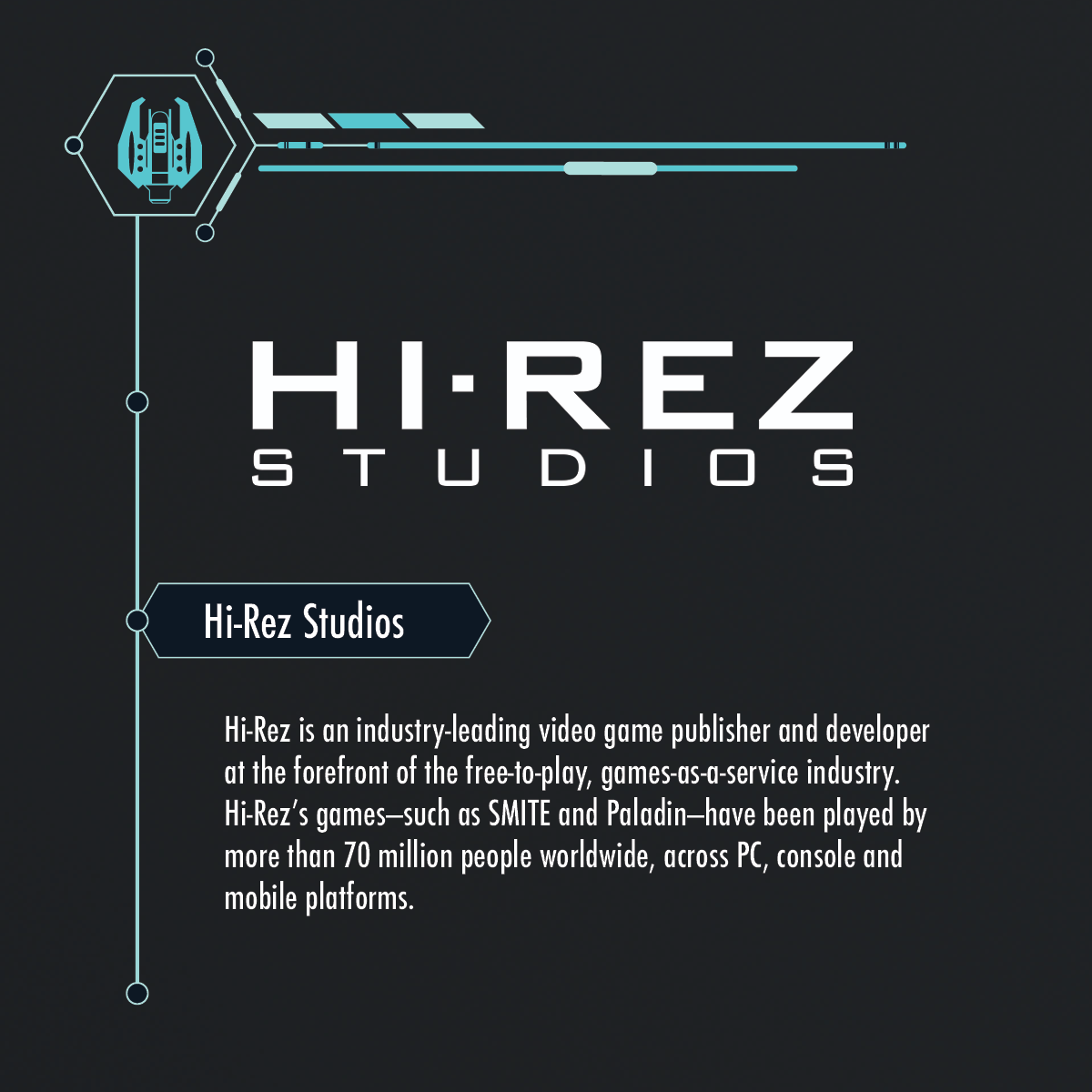
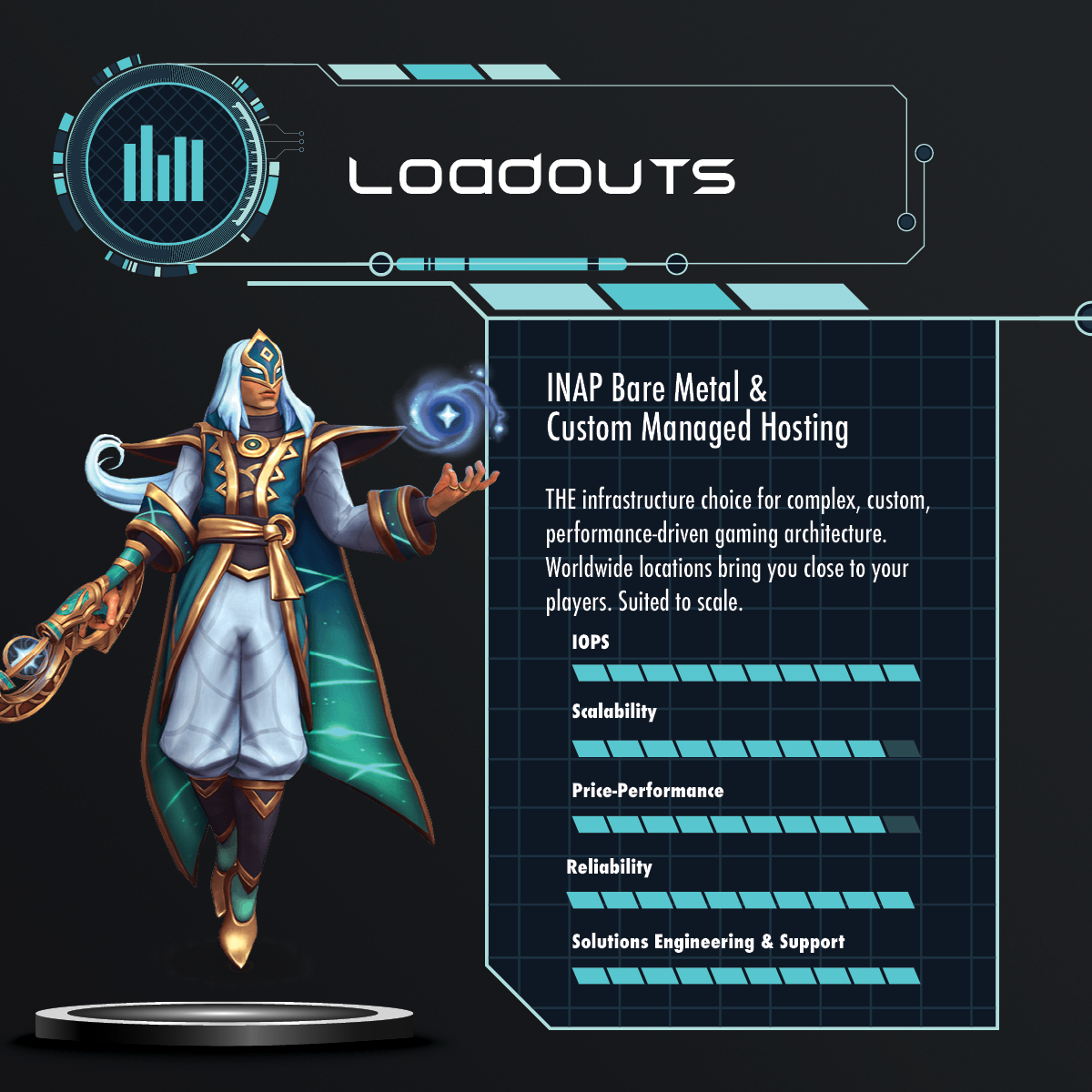
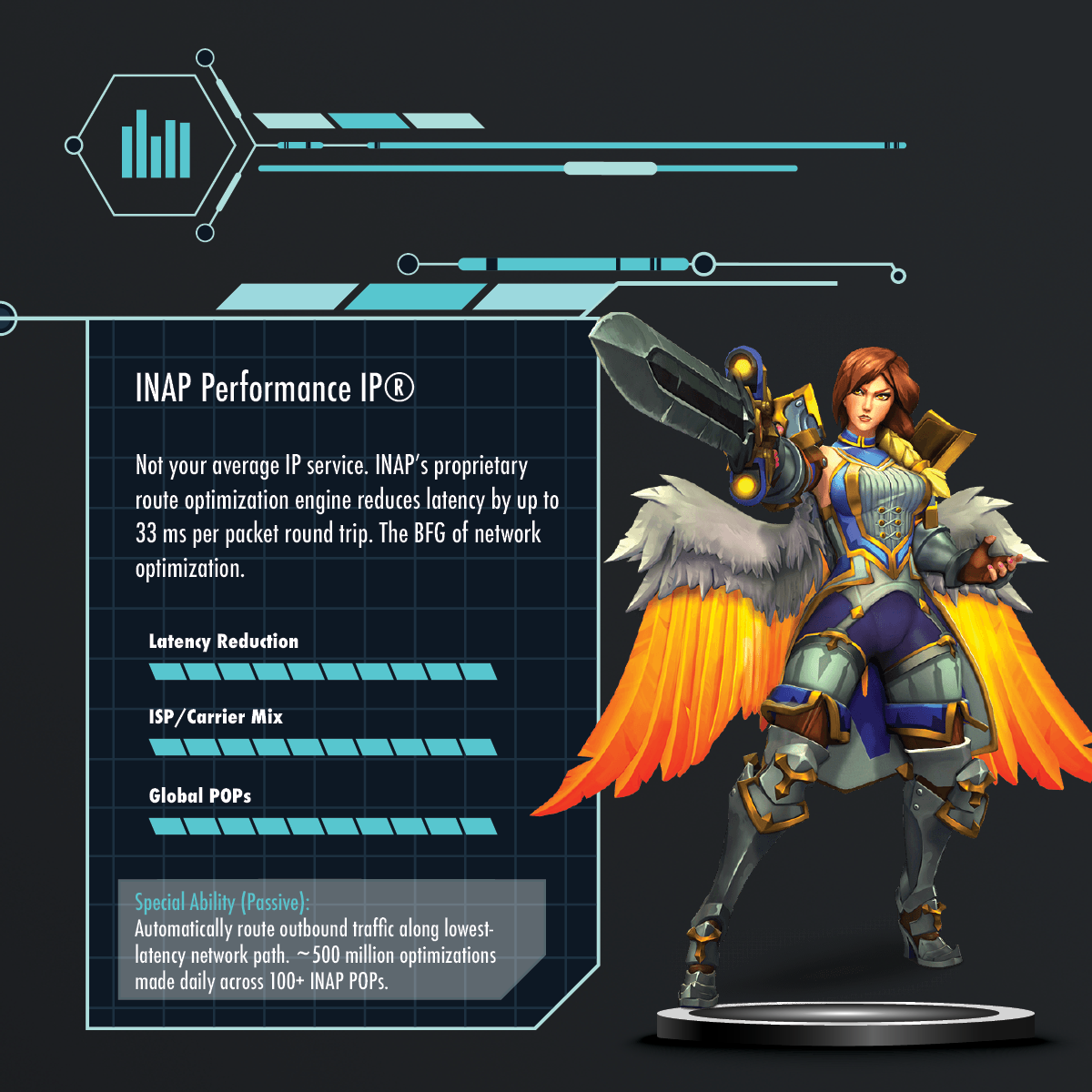
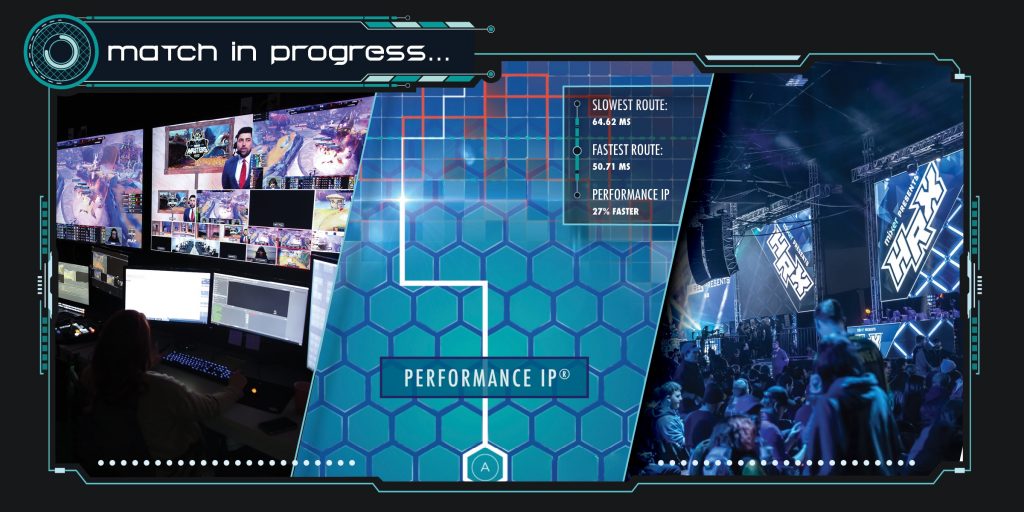
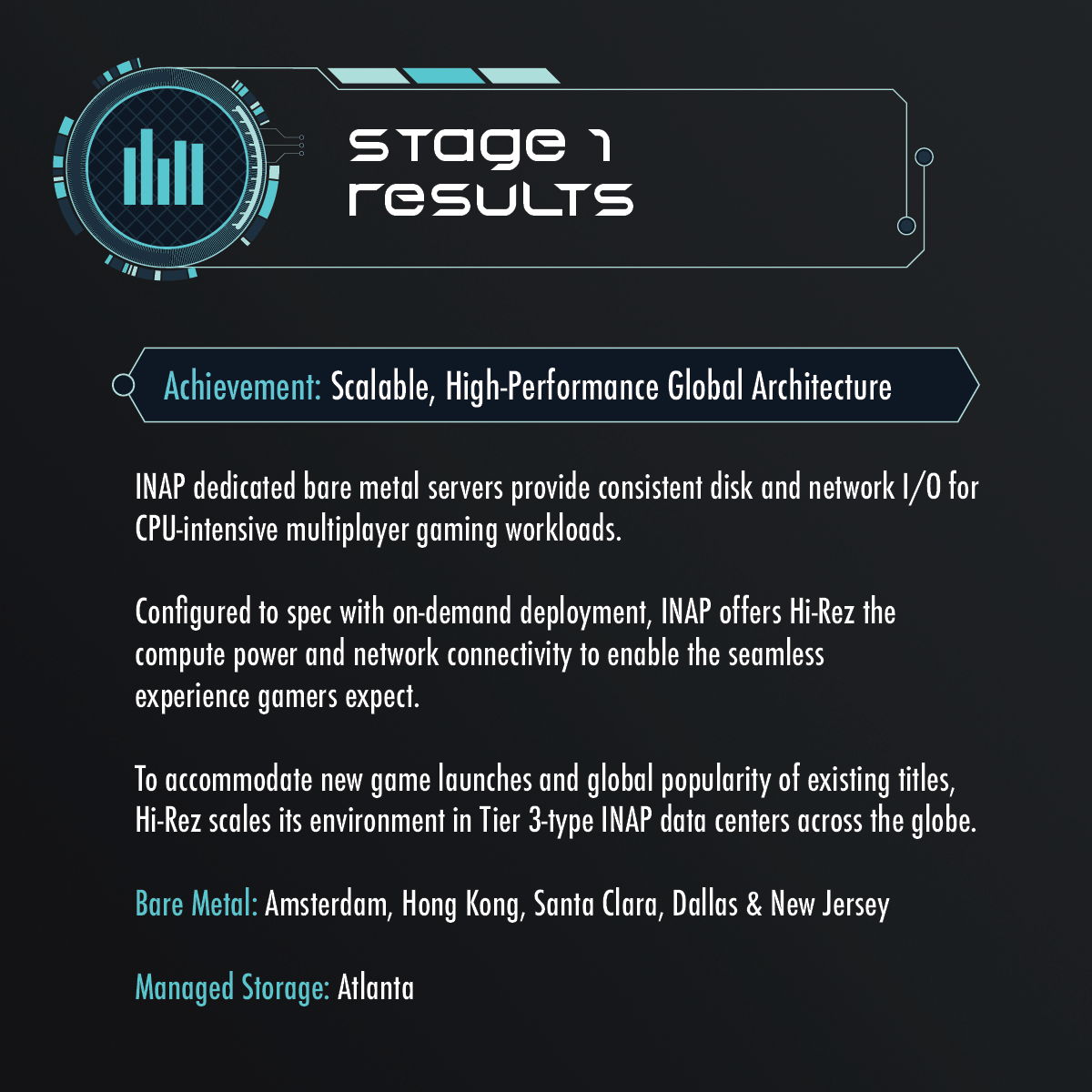
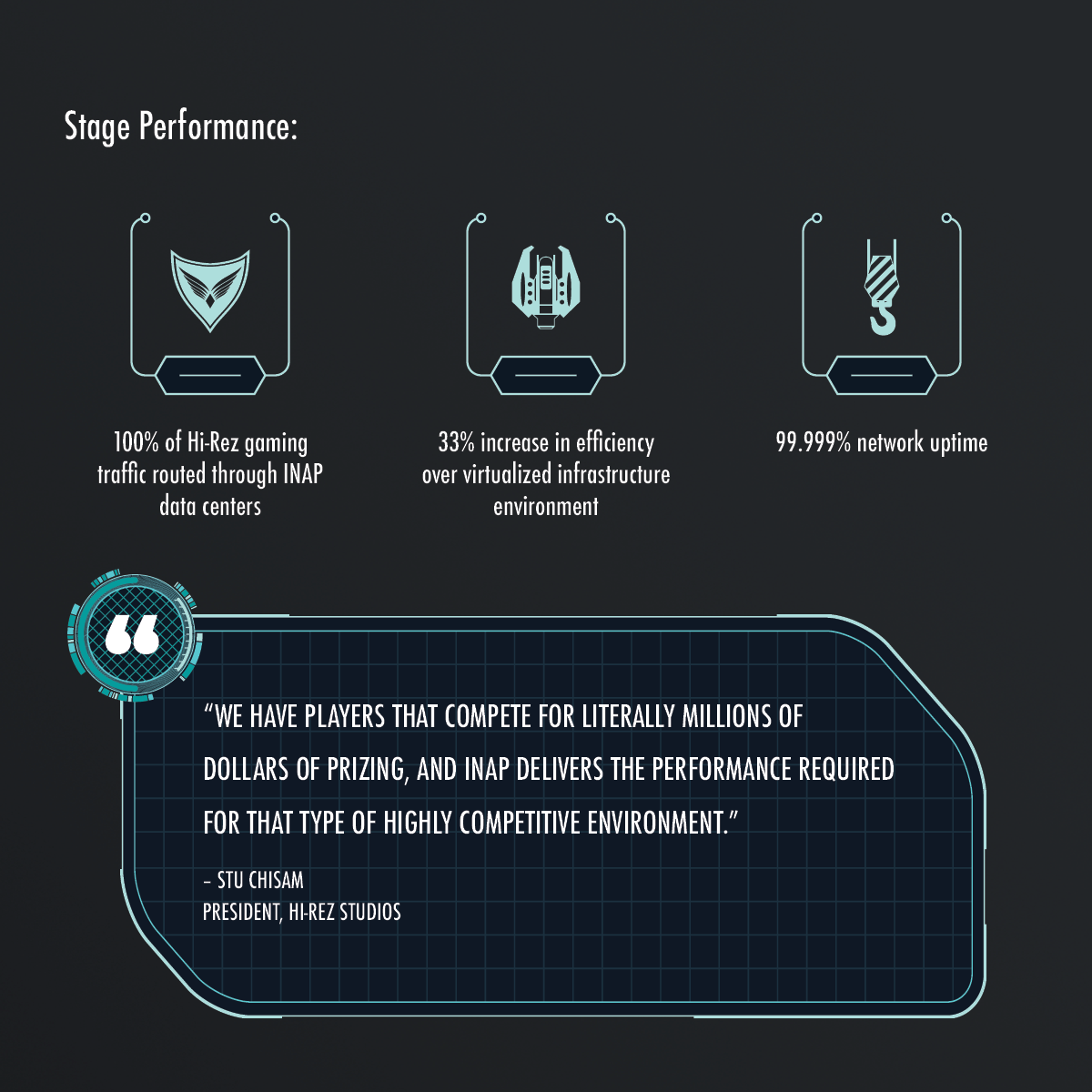
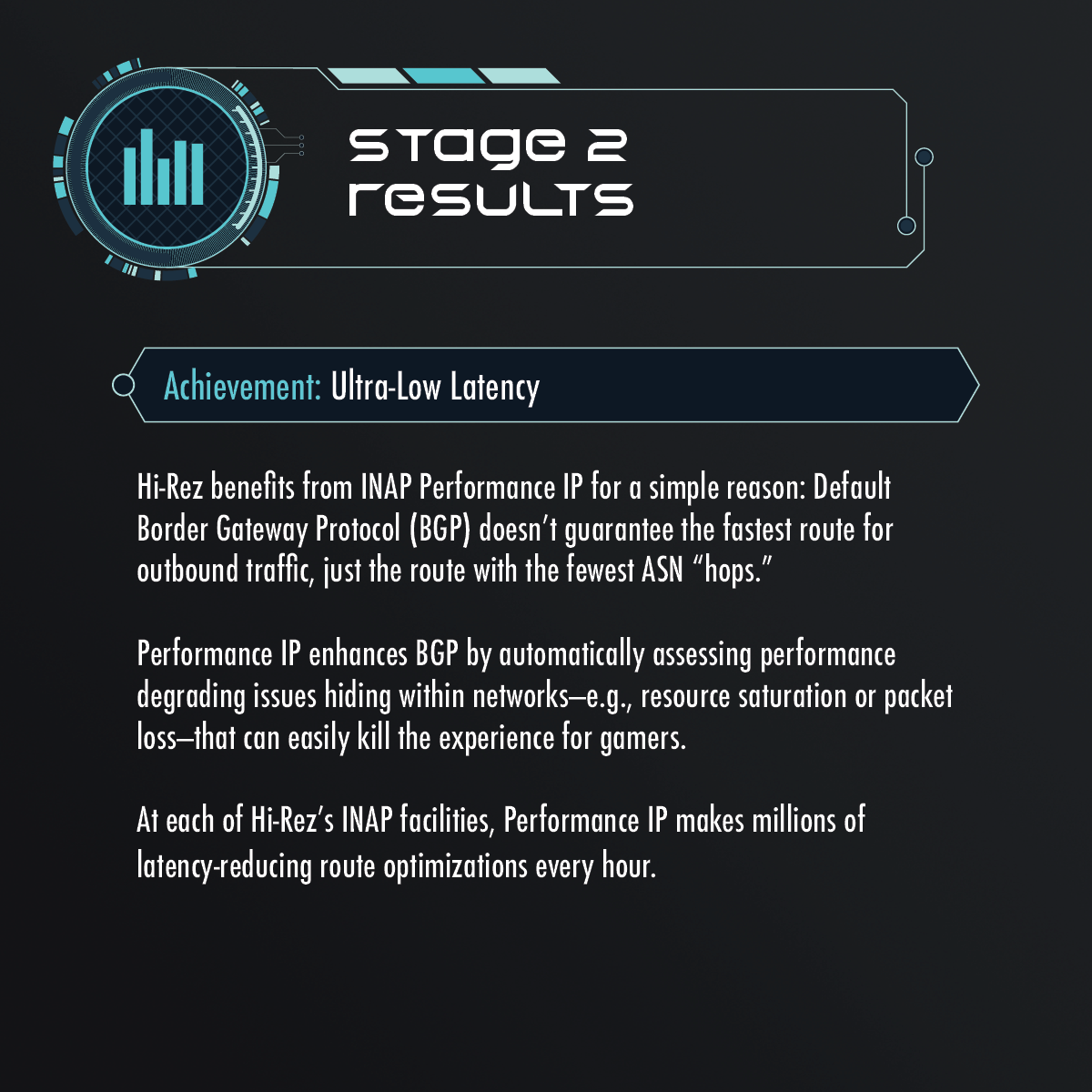
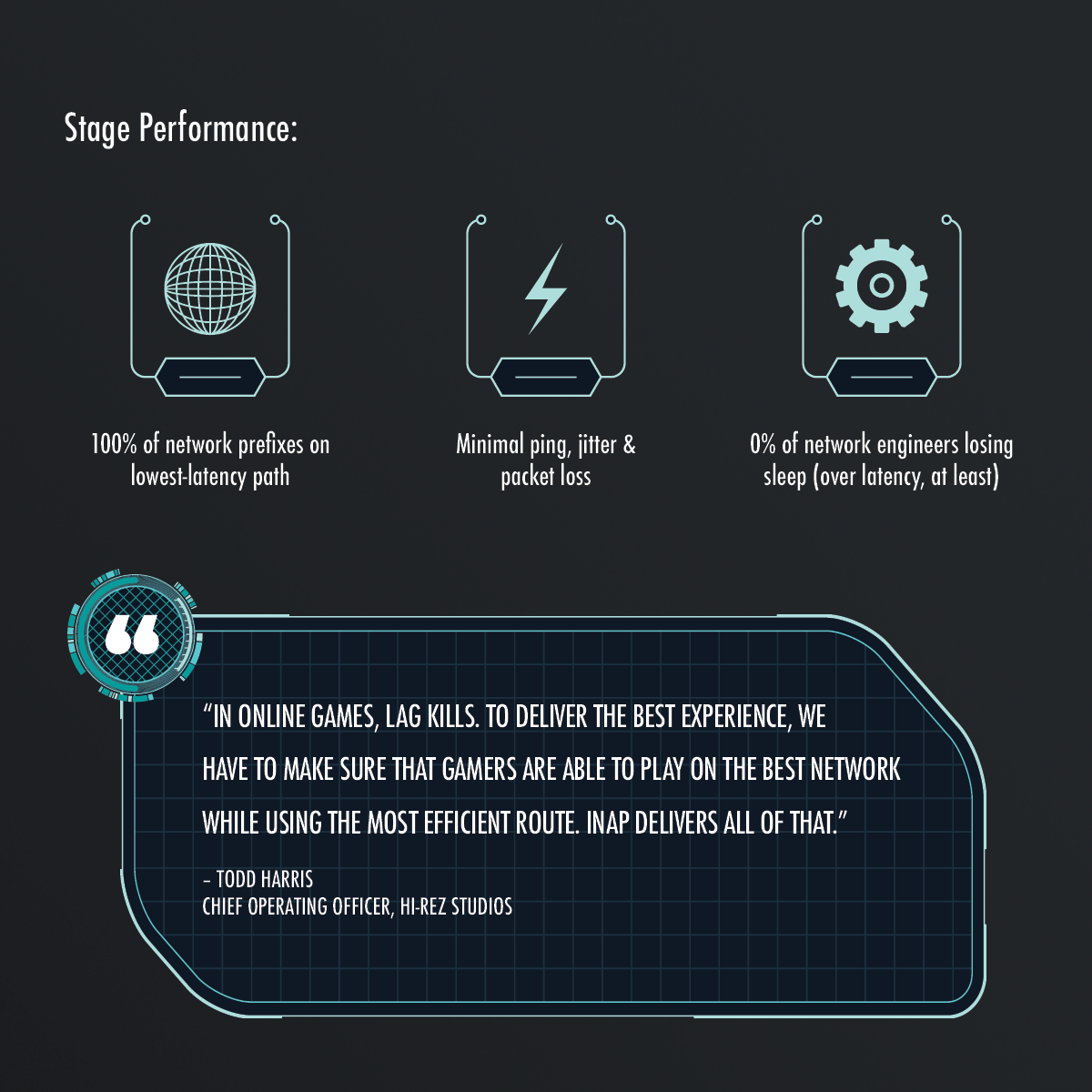
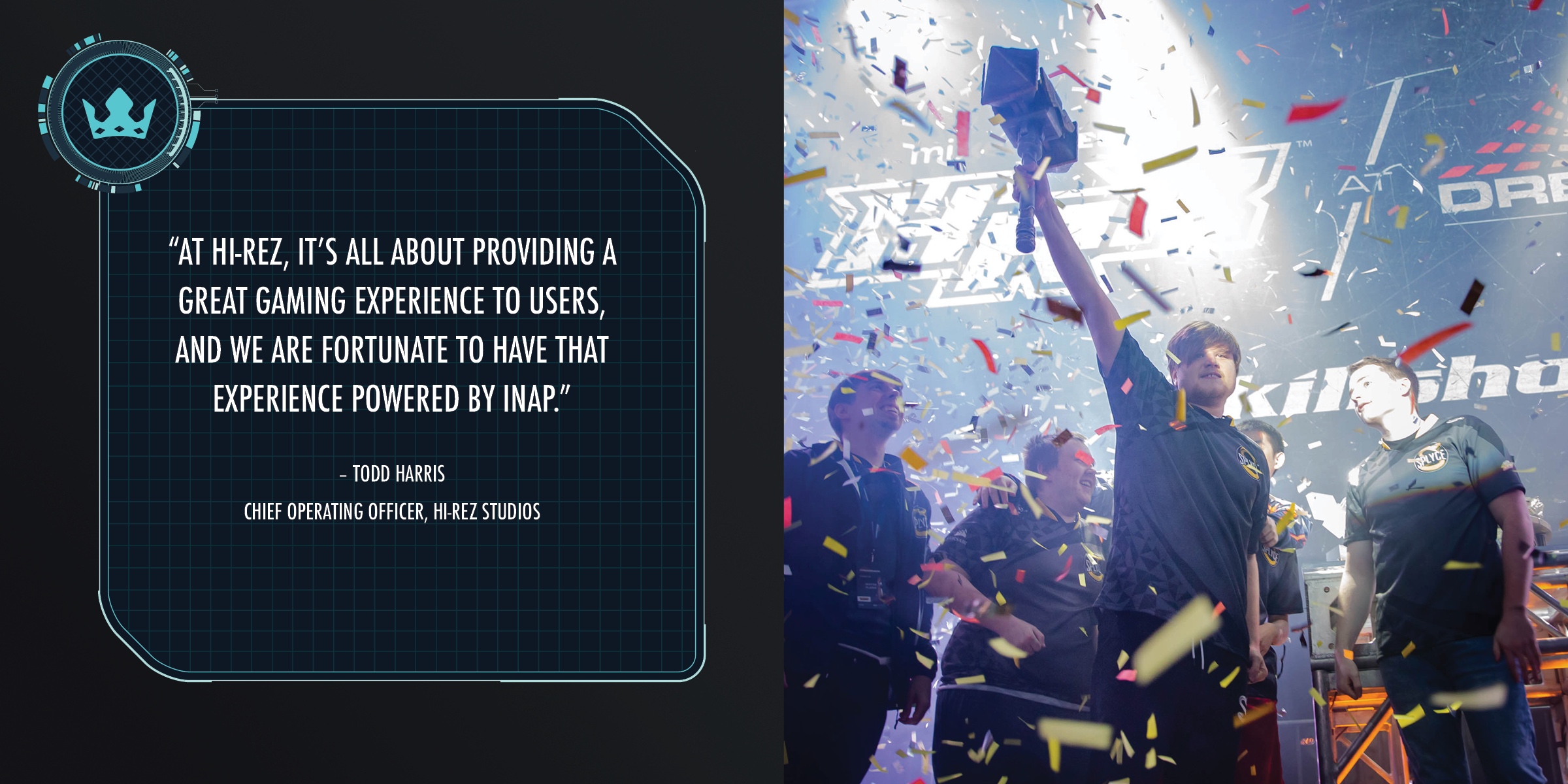
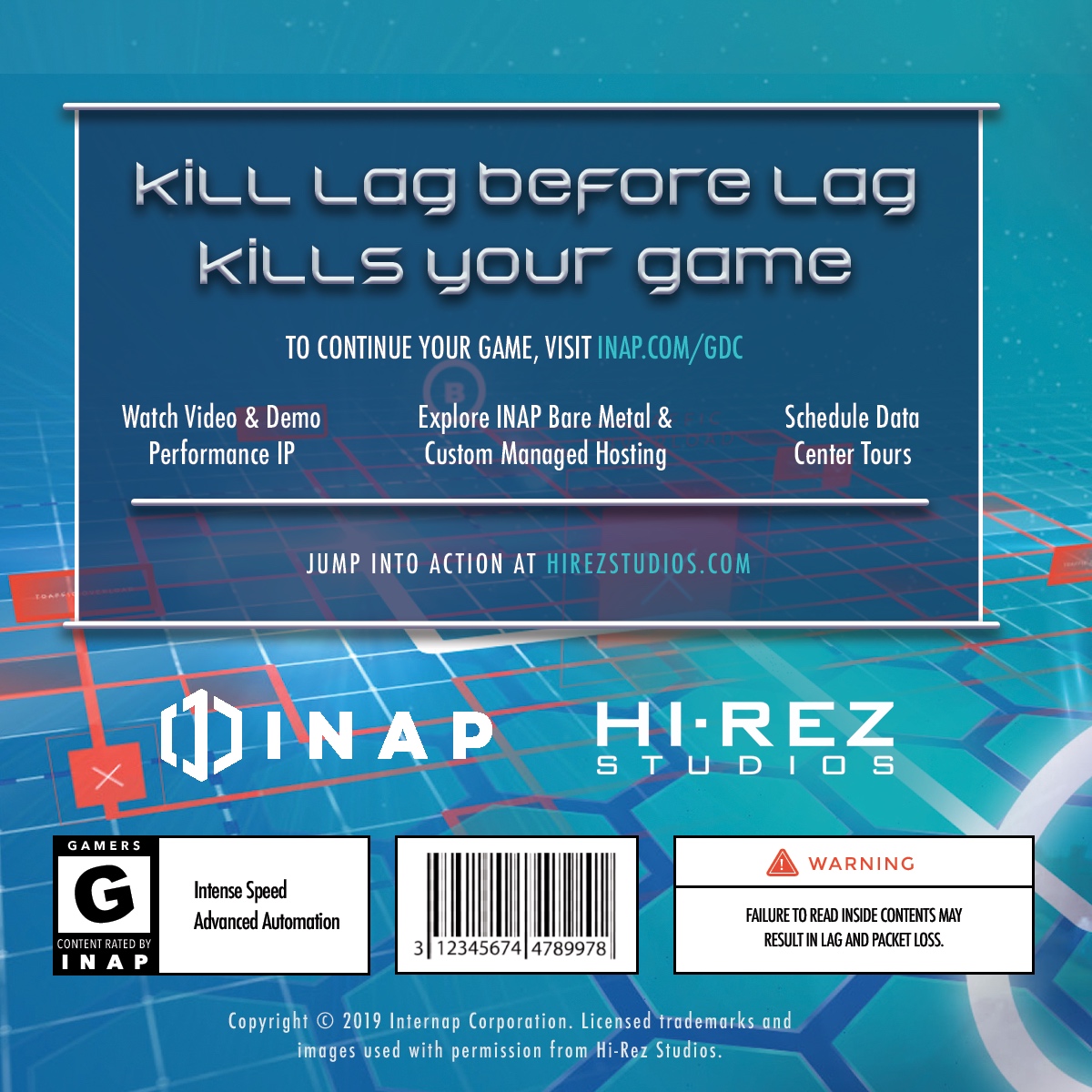
Explore HorizonIQ
Bare Metal
LEARN MORE
Stay Connected

Infrastructure for Online Gaming: Bare Metal and Colocation Reference Architecture
Bare Metal is powerful, fast and, most importantly, easily scalable—all qualities that make it perfect for resource-intensive, dynamic applications like massive online games. It’s a single-tenant environment, meaning you can harness all the computing power of the hardware for yourself (and without the need for virtualization).
And beyond that, it offers all that performance and functionality at a competitive price, even when fully customized to your performance needs and unique requirements.
Given all this, it’s easy to see why Bare Metal has quickly become the infrastructure solution of choice for gaming applications. So what does a comprehensive gaming deployment look like?
Bare Metal for Gaming: Reference Architecture
Here’s an example of what a Bare Metal deployment for gaming might look like.
1. Purpose-Built Configurations: Standard configurations are available, but one strength of Bare Metal is its customizability for specific performance needs or unique requirements.
2. Access the Edge: Solution flexibility and wide reach across a global network puts gaming platforms closer to end users for better performance.
3. Critical Services: Infrastructure designed for the needs of your application, combined with environment monitoring and support, enables the consistent performance your players expect from any high-quality gaming experience.
4. Content Delivery Networks: CDNs are perfect for executing software downloads and patch updates or for delivering cut scenes and other static embedded content quickly, while reducing loads on main servers. Read our recent blog about CDN to learn more.
5. Automated Route Optimization: Your infrastructure is nothing without a solid network to connect it to your players. Ours is powered by our proprietary Performance IP service, which ensures outbound traffic takes the lowest-latency path, reducing lag and packet loss. For more on this technology, read below.
6. Cloud Connect: On-ramp to hyperscale cloud providers—ideal for test deployments and traffic bursting. If you’re not sure what kind of cloud is right for you, our cloud experts can help you craft a flexible multicloud deployment that meets the needs of your applications and integrates seamlessly into your other infrastructure solutions.
7. Enterprise SAN Storage: Connect to a high-speed storage area network (SAN) for reliable, secure storage.
The Need for Ultra-Low Latency
In online games, latency plays a huge role in the overall gaming experience. Just a few milliseconds of lag can mean the difference between winning and losing—between an immersive experience and something that people stop playing after a few frustrated minutes.
Minimizing latency is always an ongoing battle, which is why INAP is proud of our automated route optimization engine Performance IP and its proven ability to put outbound traffic on the lowest-latency route possible.
- Enhances default Border Gateway Protocol (BGP) by automatically routing outbound traffic along the lowest-latency path
- Millions of optimizations made per location every hour
- Carrier-diverse IP blend creates network redundancy (up to 7 carriers per location)
- Supported by complex network security to protect client data and purchases
Colocation
If a hosted model isn’t right for you—maybe you want or need to bring your own hardware—Colocation might be a good way to bring the power, resiliency and availability of modern data centers to your gaming application.
1. Purpose-Built Configurations: Secure cabinets, cages and private suites can be configured to your needs.
High-Density Colocation: High power density means more bang for your footprint. INAP environments support 20+ kW per rack for efficiency and ease of scalability.
Designed for Concurrent Maintainability: Tier 3-design data centers provide component redundancy and superior availability.
2. Automated Route Optimization: Your infrastructure is nothing without a solid network to connect it to your players. Ours is powered by our proprietary Performance IP service, which ensures outbound traffic takes the lowest-latency path, reducing lag and packet loss.
3. Cloud Connect: On-ramp to hyperscale cloud providers—ideal for test deployments and traffic bursting. If you’re not sure what kind of cloud is right for you, our cloud experts can help you craft a flexible multicloud deployment that meets the needs of your applications and integrates seamlessly into your other infrastructure solutions.
4. Integrated With Private Cloud & Bare Metal: Run auxiliary or back-office applications in right-sized Private Cloud and/or Bare Metal environments engineered to meet your needs. Get onboarding and support from experts.
5. Enterprise SAN Storage: Connect to a high-speed storage area network (SAN) for reliable, secure storage.
Explore HorizonIQ
Bare Metal
LEARN MORE
Stay Connected

Content Delivery Networks (CDN) vs Cloud Computing: What’s the Difference and Do I Need Both?
It’s been over 20 years since Bill Gates declared that “content is king.” But even he probably would have had a hard time predicting back then just how much content would be consumed on the internet every single day in 2019—or how challenging delivering web applications and content to an ever-expanding global userbase could be.
The main challenges involve dealing with issues of performance and scalability. To tackle these, there are two powerful tools that can be deployed: content delivery networks (CDN) and cloud computing.
But what’s the difference, and how can you determine which suits your needs?
What are Content Delivery Networks (CDNs)?
On the most basic level, a CDN is simply a network of servers used to deliver content.
Here’s how it works: One or more servers are designated as “origin” servers, and other servers are distributed throughout various global locations as “cache” servers. These caches are strategically located to be geographically proximate to various end users: the audience. The content or source media is stored on the origin server(s) and then sent out to cache servers as needed.
When a user requests a resource or content, a special CDN URL is resolved against Domain Name Service (DNS) into an IP address to call the content from a cache server that is closer to the requesting user than the origin server. This increases the speed at which the content is delivered to end users by decreasing the distance the information must travel and thus reducing latency. It also reduces the stress on the main server(s) by distributing the load across multiple servers in different regions.
For applications that require the lowest possible latency beyond what a CDN can offer on its own, HorizonIQs’s proprietary route optimization engine Performance IP additionally cuts down latency by automatically putting outbound traffic on the fastest, best-performing route.
Content Delivery Network (CDN) Use Cases
CDN is primarily used to deliver large-file content that is often static: Video, music, and images are all common. However, it is increasingly being used for streaming media as well.
For example, an organization that delivers a streaming video content update on a weekly basis to thousands of users distributed across the U.S. might make good use of a CDN. (Your favorite video streaming service uses CDN technology too.) Contrast this with a traditional delivery method where all users connect to a centralized server. In this model, the user experience will vary based on a number of factors like their distance from the server.
Users accessing the streaming video from the other side of the country might see slow video load times and buffering issues due to higher latencies. And all users might experience delivery issues should the centralized server hit user connection limits or other resource consumption issues.
CDNs solve these issues by delivering the streaming media to local cache servers, which reduces the load on the central or origin server—lowering the likelihood of overload—and ensures that latency between the media and the users stays lower.
What Is Cloud Computing?
Cloud computing is a maturing technology strategy that can reduce the cost of delivering applications and content by taking advantage of otherwise unused computer resources.
Most computer systems largely sit idle, even when serving content and applications to a modest number of users. Server virtualization was developed to harness a single host’s resources (CPU, memory, and storage) and share them with several virtual machines (VM), each running their own applications and serving their own content.
Hypervisor technology, which controls virtualized servers, has advanced considerably since the advent of the cloud and has evolved to enable the management of a cluster of hosts running several VMs each that share resources even in the event of a physical host malfunctioning. In this way, cloud technologies and VMs add resiliency and reliability to hosted applications by abstracting their functionality from the underlying physical hardware.
VM images can also be shared and deployed in several regions, allowing your applications to be delivered closer to the end user for increased performance and lower latency, acting like a CDN. As the number of users increases, it is easier, cheaper, and faster to spin up a new VM than it is to procure new hardware.
Cloud computing comes in several flavors, from custom-designed private clouds and high-powered bare metal configurations to hyperscale public cloud providers like AWS and Azure.
Cloud Computing Use Cases
While the primary functionality of cloud computing is more efficient resource management of hosts and networks to reduce the costs of delivering content and applications, the technology also allows you to easily deploy server images to an allocated host or cluster of hosts. It can thus be used to enhance the user experience by placing the application or content in multiple regions very easily, and distributing resources like a CDN.
Disaster recovery strategies can also be built into the delivery of the application by either failing over to a hot standby environment or quickly spinning up planned resources to replicate the application environment in another geographic location.
A common use case: An organization deploys cloud computing environments to lower its hardware expenditures by sharing resources across several virtual machines. This is preferable to having one physical host per application function (e.g., databases, GUI, etc.). As the application’s user base expands, the organization can easily add servers by spinning up new virtual hosts with templates for the required functionality.
CDN and Cloud Computing Together
To recap: CDN provides a platform for delivering large amounts of content closer to the end user, while cloud computing allows for easily scaling resources for applications.
Using both a CDN and cloud computing strategies together creates a more resilient and reliable delivery strategy for your applications and content than either could do alone. They eliminate single points of failure in delivering applications and the content that power them, while making smart, efficient use of resources.
And if your managed service provider offers both, you can simplify your partner relationships, while leveraging their combined expertise.
Explore HorizonIQ
Bare Metal
LEARN MORE
Stay Connected

GDC 2019 is just a few weeks away, and we couldn’t be more excited. Here at INAP, we’re passionate about the gaming industry, and we’re proud that our data center, cloud and network solutions power industry leaders like game developer and publisher Hi-Rez Studios; cloud gaming service Shadow; Mineplex, one of the world’s most popular Minecraft servers; and Super Evil Megacorp, makers of cross-platform MOBA Vainglory.
If you’ll be attending, stop by our booth, P1855, to say hi and see how Performance IP, INAP’s one-of-a-kind route optimization technology, and our full suite of high-performance infrastructure and network solutions power some of your favorite gaming experiences.
In the meantime, here are just a handful of the sessions we’re most looking forward to.
The eSports Game Experience
The rise of eSports has proven that gaming might have what it takes to become a truly blockbuster spectator sport (even more than it already is). These sessions will tackle the tricky business of making games more enjoyable and inclusive for everyone, no matter who’s playing (or watching).
Esports Day: Diversity and Inclusion in Esports: Where It Is, Where It’s Going, and How It’s Being Done
Date: Monday, March 18
Time: 10:00 a.m. – 11:00 a.m.
The first half-hour of this two-part session will provide attendees a clear sense of what techniques are working right now to increase inclusion in eSports and offer a plan of action to eSports community builders and players to further the effort.
The second half will cover the work of UC Irvine’s Esports Arena staff. They are collaborating with campus academics to examine eSports scholarship players’ code of conduct and contract language in an effort to develop policies that promote inclusion and protect against harassment, especially identity-based harassment.
Tackling Audience Experiences in Games
Date: Monday, March 18
Time: 3:50 p.m. – 4:20 p.m.
The audience of your game isn’t just the people playing your game—it’s also the viewers watching them play. How can you design games with a focus on optimizing the experience of both the players and the audience? This session will demonstrate how to design user interfaces and game mechanics that make for the best live or streamed gaming experience.
Esports Day: WiFi Warriors: How Developers and Organizers Can Improve Online Tournaments
Date: Monday, March 18
Time: 4:40 p.m. – 5:10 p.m.
From first-person shooters like CounterStrike and Call of Duty to fighting games like Street Fighter and Super Smash Bros., tournaments have always been an integral part of the gaming experience. This session will dissect various ways developers and communities have created methods for implementing online tournaments and how to use them to create an effective online tournament for your next competitive game. It’ll dive into various aspects of the experience, including streaming, spectators and third-party tools, and how to create the best tournament experience for games in 1v1, 5v5 and battle royale genres.
The Challenges of Developing a Game
Latency can be a game-killer. How do developers account for delay from networks and inside their games, and how can you make sure that the gaming experience stays smooth and responsive? And even once you’ve built a solid game, how do you get it made?
So You’re Ready to Pitch to a Publisher? You’re Not
Date: Monday, March 18
Time: 10:00 a.m. – 11:00 a.m.
At some point in development, your team will have to talk about your game with someone on the outside. But how do you know if what you’re saying and showing make sense? Are you soliciting for publishers, for funding, for console co-marketing, for promotional opportunities, or are you going to a convention? Learn the difference between prototypes, gameplay mechanic tests and vertical slices—and why publishers want them.
Controller to Display Latency in Call of Duty
Date: Wednesday, March 20
Time: 9:00 a.m. – 10:00 a.m.
Low input latency is key to a satisfying experience in competitive games, but reasoning about latency can be non-intuitive in modern engines with multiple parallel timelines running at once. This talk will tackle latency by analyzing the path that data flows through a game engine from the input sample all the way to the video scan-out hardware.
Technical Challenges of Developing Multiplayer Shooters
Date: Wednesday, March 20
Time: 3:30 p.m. – 4:30 p.m.
This session will give insight into using first- and third-person perspectives for multiplayer games, the pros and cons of using weapon view models, network optimization for multiple NPCs, as well as animation data optimization taken from the speaker’s real-life projects.









